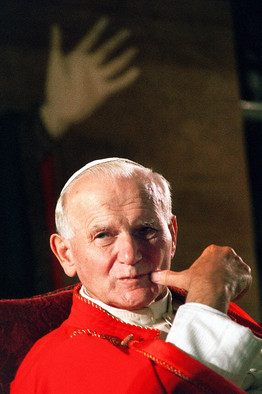
So maybe it’s time to look beyond the lawyers and landmark preservation commissions and regulatory agencies. When we do, it will be hard to find a better example than the grace and wisdom Pope John Paul II exhibited during a similar clash involving another hallowed site on whose grounds innocents were also murdered: Auschwitz.
In the 1980s, Carmelite nuns moved into an abandoned building on the edge of the former Nazi death camp to pray for the souls taken there. As with the dispute over the mosque near Ground Zero, the convent’s presence escalated into a clash not only between different faiths but between competing historical narratives. As with today’s clash too, it seemed intractable until the Polish pope stepped in.
For Jews, Auschwitz is a symbol of the Shoah, and the presence of a convent looked like an effort to Christianize a place of Jewish suffering. Suspicions were further aroused by a fundraising brochure from an outside Catholic group, which referred to the convent as a “guarantee of the conversion of strayed brothers.” The protests mounted over the course of several years and various interfaith agreements, and pointed to the real strains that remained between Poles and Jews over a shared history with very different perspectives.
Many Catholics, not just in Poland, could not understand how nuns begging God’s forgiveness and praying for the souls of the departed could possibly offend anyone. There was also a nationalist element. Many members of the Polish resistance had also been murdered at Auschwitz. And again like our present controversy at Ground Zero, intemperate reactions and statements from both sides only inflamed passions.
So what did Pope John Paul II do? He waited, and he counseled. And when he saw that the nuns were not budging—and that their presence was doing more harm than good—he asked the Carmelites to move. He acknowledged that his letter would probably be a trial to each of the sisters, but asked them to accept it while continuing to pursue their mission in that same city at another convent that had been built for them.
Let’s remember what this means. By their own lights, the nuns believed they were doing only good. They may have had a legal title to be where they were. And it is likely that they never would have been forced to move by local authorities had they insisted on staying.
There’s a lesson here. Even those who favor this new Islamic Center surely can appreciate why some American feelings are rubbed raw by the idea of a mosque at a place where Islamic terrorists killed more than 2,700 innocent people. If feelings in Auschwitz were raw after nearly half a century, it’s not hard to see why they would remain raw at Ground Zero after less than a decade.
On the other hand, Mayor Michael Bloomberg is right about the law: Our freedom of religion means nothing if it doesn’t mean freedom of religion for all. Indeed, the Becket Fund for Religious Liberty—a sort of ACLU for freedom of religion—has spent decades defending churches, synagogues, mosques and even a Zoroastrian temple against public officials who have tried to invoke zoning laws or arcane regulations to keep them off a property.
Yet not all big questions can—or should—be reduced to legal right. Living together as neighbors in a free and inescapably diverse society requires more skills than just knowing how to hire sharp lawyers. Sometimes it requires leaders willing to sound a grace note, even yielding to the feelings of others who may not see our plans the same way we do.
For their part, the two people at the heart of this center—Imam Feisal Abdul Rauf and his wife, Daisy Khan—defend the center as an antidote to 9/11. “Our religion has been hijacked by the extremists,” Ms. Khan told National Public Radio, “and this center is going to create that counter-momentum which will amplify the voices of the moderate Muslims.”
Perhaps. But it’s hard to argue with the Anti-Defamation League’s assessment that the controversy created by building the center at this location “is counterproductive to the healing process.”
Without doubt Pope John Paul II did not share the more malevolent interpretations attached to the presence of the Carmelites at Auschwitz. By asking the nuns to withdraw, he didn’t concede them either. What he did was recognize that having the right to do something doesn’t mean it’s the right thing to do.


Artículos Relacionados: